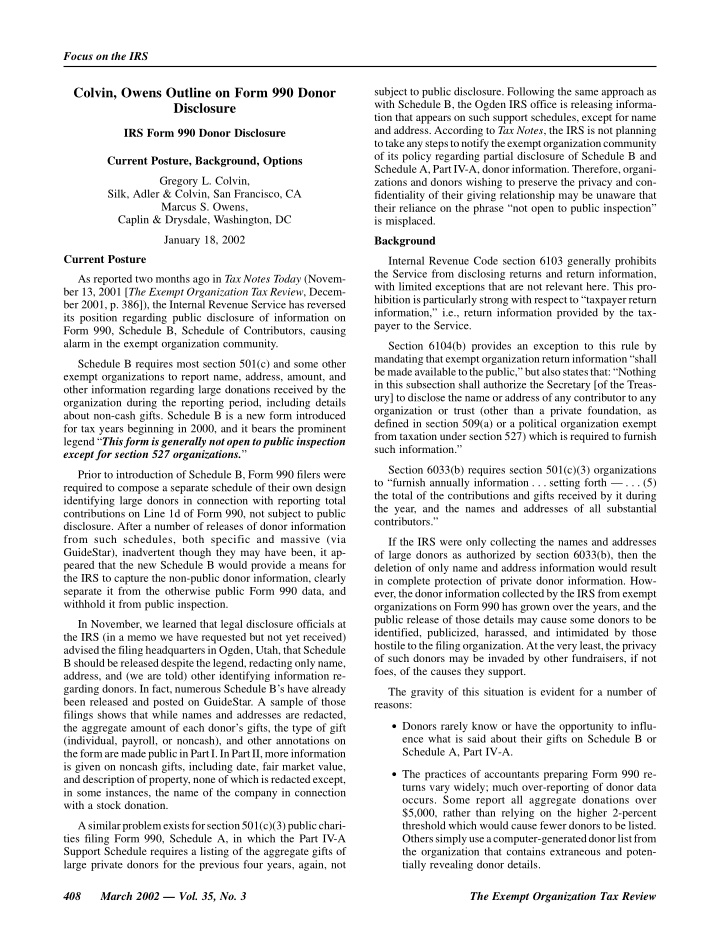



Focus on the IRS subject to public disclosure. Following the same approach as Colvin, Owens Outline on Form 990 Donor with Schedule B, the Ogden IRS office is releasing informa- Disclosure tion that appears on such support schedules, except for name and address. According to Tax Notes , the IRS is not planning IRS Form 990 Donor Disclosure to take any steps to notify the exempt organization community of its policy regarding partial disclosure of Schedule B and Current Posture, Background, Options Schedule A, Part IV-A, donor information. Therefore, organi- Gregory L. Colvin, zations and donors wishing to preserve the privacy and con- Silk, Adler & Colvin, San Francisco, CA fidentiality of their giving relationship may be unaware that Marcus S. Owens, their reliance on the phrase “not open to public inspection” Caplin & Drysdale, Washington, DC is misplaced. January 18, 2002 Background Current Posture Internal Revenue Code section 6103 generally prohibits the Service from disclosing returns and return information, As reported two months ago in Tax Notes Today (Novem- with limited exceptions that are not relevant here. This pro- ber 13, 2001 [ The Exempt Organization Tax Review , Decem- hibition is particularly strong with respect to “taxpayer return ber 2001, p. 386]), the Internal Revenue Service has reversed information,” i.e., return information provided by the tax- its position regarding public disclosure of information on payer to the Service. Form 990, Schedule B, Schedule of Contributors, causing alarm in the exempt organization community. Section 6104(b) provides an exception to this rule by mandating that exempt organization return information “shall Schedule B requires most section 501(c) and some other be made available to the public,” but also states that: “Nothing exempt organizations to report name, address, amount, and in this subsection shall authorize the Secretary [of the Treas- other information regarding large donations received by the ury] to disclose the name or address of any contributor to any organization during the reporting period, including details organization or trust (other than a private foundation, as about non-cash gifts. Schedule B is a new form introduced defined in section 509(a) or a political organization exempt for tax years beginning in 2000, and it bears the prominent from taxation under section 527) which is required to furnish legend “ This form is generally not open to public inspection such information.” except for section 527 organizations. ” Section 6033(b) requires section 501(c)(3) organizations Prior to introduction of Schedule B, Form 990 filers were to “furnish annually information . . . setting forth — . . . (5) required to compose a separate schedule of their own design the total of the contributions and gifts received by it during identifying large donors in connection with reporting total the year, and the names and addresses of all substantial contributions on Line 1d of Form 990, not subject to public contributors.” disclosure. After a number of releases of donor information from such schedules, both specific and massive (via If the IRS were only collecting the names and addresses GuideStar), inadvertent though they may have been, it ap- of large donors as authorized by section 6033(b), then the peared that the new Schedule B would provide a means for deletion of only name and address information would result the IRS to capture the non-public donor information, clearly in complete protection of private donor information. How- separate it from the otherwise public Form 990 data, and ever, the donor information collected by the IRS from exempt withhold it from public inspection. organizations on Form 990 has grown over the years, and the public release of those details may cause some donors to be In November, we learned that legal disclosure officials at identified, publicized, harassed, and intimidated by those the IRS (in a memo we have requested but not yet received) hostile to the filing organization. At the very least, the privacy advised the filing headquarters in Ogden, Utah, that Schedule of such donors may be invaded by other fundraisers, if not B should be released despite the legend, redacting only name, foes, of the causes they support. address, and (we are told) other identifying information re- garding donors. In fact, numerous Schedule B’s have already The gravity of this situation is evident for a number of been released and posted on GuideStar. A sample of those reasons: filings shows that while names and addresses are redacted, • Donors rarely know or have the opportunity to influ- the aggregate amount of each donor’s gifts, the type of gift ence what is said about their gifts on Schedule B or (individual, payroll, or noncash), and other annotations on Schedule A, Part IV-A. the form are made public in Part I. In Part II, more information is given on noncash gifts, including date, fair market value, • The practices of accountants preparing Form 990 re- and description of property, none of which is redacted except, turns vary widely; much over-reporting of donor data in some instances, the name of the company in connection occurs. Some report all aggregate donations over with a stock donation. $5,000, rather than relying on the higher 2-percent A similar problem exists for section 501(c)(3) public chari- threshold which would cause fewer donors to be listed. ties filing Form 990, Schedule A, in which the Part IV-A Others simply use a computer-generateddonor list from Support Schedule requires a listing of the aggregate gifts of the organization that contains extraneous and poten- large private donors for the previous four years, again, not tially revealing donor details. 408 March 2002 — Vol. 35, No. 3 The Exempt Organization Tax Review
Recommend
More recommend